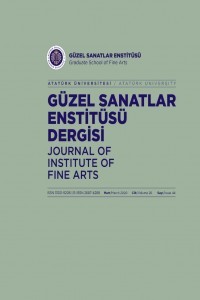BAYBURT DAĞÇATI KÖYÜ CAMİİ VE ÇEŞMESİ / Bayburt Dağçatı Village Mosque and the Fountain
Bayburt, Geleneksel, Osmanlı, Cami, Kalemişi Süsleme.
-
Bayburt, Traditional, Ottoman, Mosque, Hand -Down Decoration.,
___
- Arık, R.(1988). Batılıla şma Dönemi Anadolu Tasvir Sanatı, Ankara.
- Bozer, R. (1987). “Kula Emre Köyünde Resimli Bir Cami”, Türkiyemiz, S.53, 15-22.
- Ça ğlıtütüncügil, E. (2013). “Türk Süsleme Sanatında Nar: “Form, Köken ve İkonografik Anlamı” Türklük Bilimi Araştırmaları, XXXIII, 61-92. Çal, H.(1993). “Tokat Zile Ye şilce Köyü Şeyh Eylük Türbesi” Selçuk Üniversitesi Selçuklu Ara ştırmaları Merkezi Prof. Dr. Yılmaz Önge Arma ğanı, Konya, 293-306.
- Denkta ş, M. (2001). “Kayseri- Develi Şıhlı Kasabası Yusufağa Cami”, Prof. Dr. Zafer Bayburtluo ğlu’na Armağan, Sanat Yazıları, Kayseri, 20120
- Denkta ş, M. (2004). “Pınarbaşı Uzunyayla’daki Ahşap Direkli Camiler”, E. Ü. Sosyal Bilimler Enstitüsü Dergisi, S.16, Kayseri, 53-89.
- Duran, R.(1992). “Seki-Tekke Camii ve Tekke Sanatı ile İlgisi Üzerine” Dokuz Eylül Üniversitesi, İlahiyat Fakültesi Dergisi, VII, İzmir, 3233
- Karpuz, H.(1990). “Trabzon’un Çaykara İlçesi Köylerinde Bulunan Bazı Camiler” Vakıflar Dergisi, Sayı, XXI, İstanbul, 281-299.
- Kö şklü, Z.(1993). I. Abdülhamid Dönemi (1774–1789) Osmanlı Dini Mimarisi, Atatürk Üniversitesi Sosyal Bilimler Enstitüsü Arkeoloji ve Sanat Tarihi Anabilim Dalı (Yayımlanmamı ş ) Yüksek Lisans Tezi, Erzurum.
- Renda, G.(1984). “19.yüzyılda Kalemi şi Nakış-Duvar Resmi”, Tanzimattan Cumhuriyete Türkiye Ansiklopedisi, C.6, İstanbul, 1530-1533.
- Sa ğıroğlu, A.(2005). Kayseri Zamantı Irmağı Çevresindeki Bezemeli Mezar Ta şları, Kayseri. Harita 1: Bayburt/ Da ğçatı Köyü Konumu.
- ISSN: 1300-9206
- Yayın Aralığı: Aylık
- Yayıncı: Atatürk Üniversitesi
Bilal SEZER, Pelin Güleda KARADENİZ
HATTAT KEVKEB MEHMED EFENDİ’NİN TALEBESİ HATTAT DERVİŞ HÜSEYİN EFENDİ’YE AİT BİR KUR’ÂN-I KERİM
KEMAH ve KEMAH KALESİ KAZILARI / Kemah and Excavetıons of Kemah Castle
Hüseyin YURTTAŞ, Haldun ÖZKAN, Zerrin KÖŞKLÜ, Muhammet Lütfü KINDIĞILI
RUS NON-KONFORMİZMİ / Russian Non-Comformism
PROF.DR. ZAFER BAYBURTLUOĞLU'NUN HAYATI ve ESERLERİ
ALEXANDER CALDER’İN AÇIK YAPITLARI (1898-1976)
Mustafa BULAT, Serap BULAT, Barış AYDIN
ŞİRVAZ KALESİ VE KAYAÜSTÜ RESİMLERİ (ŞENKAYA-ERZURUM)
Cemal SEVİNDİ, Ali Yalçın TAVUKÇU
BAYBURT DAĞÇATI KÖYÜ CAMİİ VE ÇEŞMESİ / Bayburt Dağçatı Village Mosque and the Fountain
